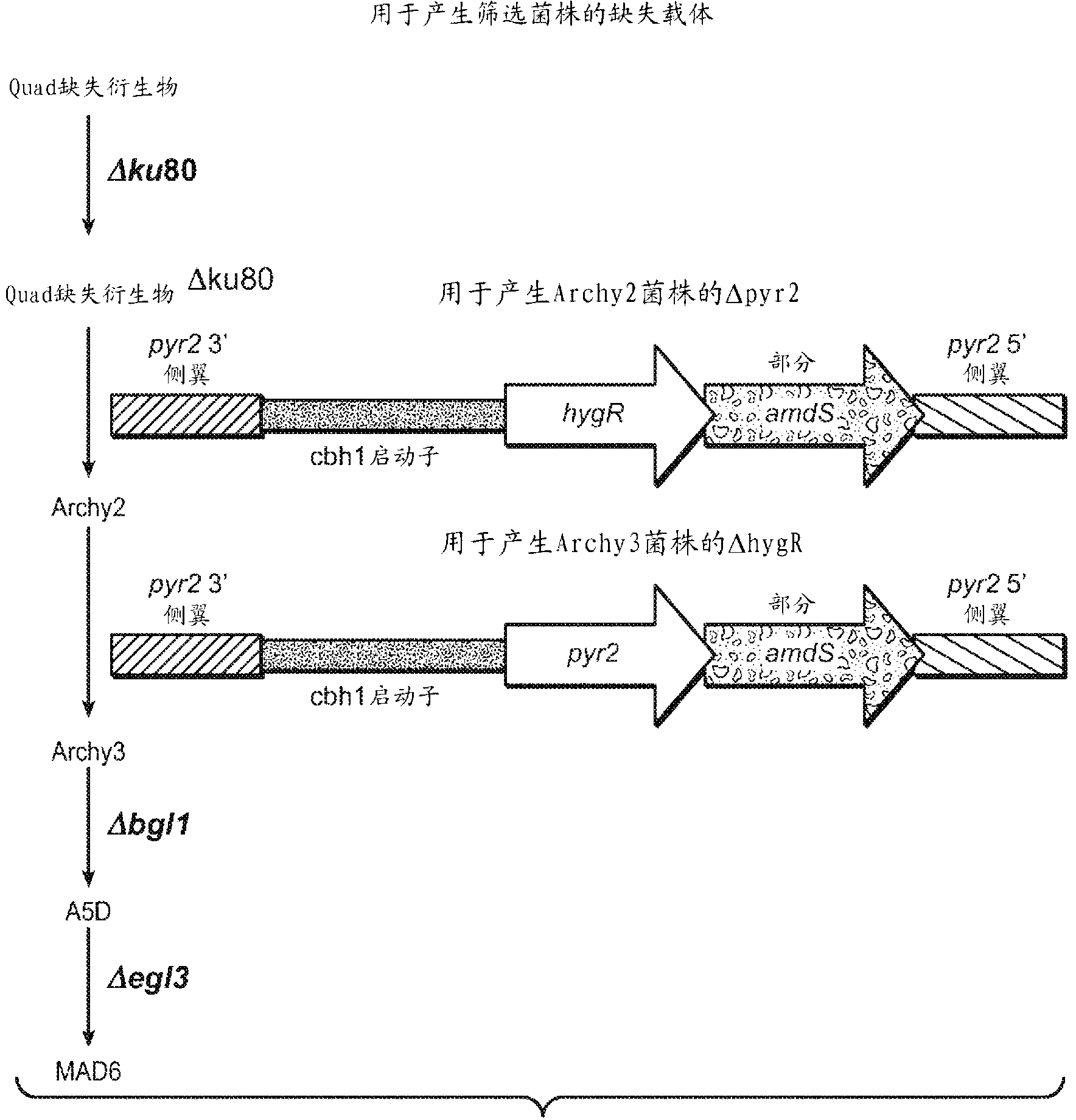Filamentous fungal host strains and DNA constructs, and methods of use thereof
A technology for filamentous fungi and fungi, which can be applied to recombinant DNA technology, botanical equipment and methods, biochemical equipment and methods, etc., and can solve problems such as not eliminating the variability of the expression level of transformants
- Summary
- Abstract
- Description
- Claims
- Application Information
AI Technical Summary
Problems solved by technology
Method used
Image
Examples
Embodiment 1
[0133] Generation of Trichoderma reesei expression strains
[0134] Improved strains are generated to increase the uniformity of expression of the variant of interest (in this case, the CBH2 variant), such that expression levels vary less between variants of the same amino acid sequence. Specifically, T. reesei strains were developed in combination with targeting vectors that force the integration of cbh2 variant genes (eg, coding regions in operative combination with regulatory sequences). New strains prepared during the development of the present invention combined several mutations that were advantageous for screening variant libraries. A schematic diagram of the genetic engineering steps is shown in figure 1 middle.
[0135] Deletion of ku80 from Trichoderma reesei quad deletion derivative strain
[0136] Quad deletion derivative strains are described in PCT Publication WO 2005 / 001036. A single ortholog of MUS52, the Neurospora crassa ortholog of human KU80, was id...
Embodiment 2
[0155] Enzyme expression comparison: Qnad deletion strain compared to MAD6 strain
[0156] 1. Preparation of vector
[0157] Expression of two glycosyl hydrolase family 43 proteins in Trichoderma reesei strains, Archy3 and quad deletion strains. use Cloning system (Invitrogen), the genes fv43B and fv43C were cloned from Fusarium verticillioides genomic DNA and assembled into expression vector pTrex3gM. Such as Figure 9 These two genes were initially cloned into the pENTR / D-TOPO vector (Invitrogen) as shown in .
[0158] The gene was then recombined into the vector pTrex3gM, in which the cbhl promoter was upstream of the coding sequence of the gene of interest and the cbhl terminator was downstream of the stop codon of the gene of interest. This vector additionally contains an Aspergillus nidulans amidase (amdS) selectable marker located 3' to the cbhl terminator. This carrier is shown in FIG. 10 .
[0159] The resulting Fv43B expression vector, pTrex3gM-Fv43B, is s...
Embodiment 3
[0203] Generation of H. jecorina CBH2 DNA library
[0204] The pTTTpyrG-cbh2 plasmid containing the H. jecorina CBH2 protein coding sequence (see eg, PCT Publication WO 2010 / 141779) was used as a reference sequence for generating a DNA library encoding CBH2 variant enzymes.
[0205] SEQ ID NO: 7 shows the reference H. jecorina CBH2 encoding DNA sequence:
[0206] ATGATTGTCGGCATTCTCACCACGCTGGCTACGCTGGCCACACTCGCAGCTAGTGTGCCTCTAGAGGAGCGGCAAGCTTGCTCAAGCGTCTGGGGCCAATGTGGTGGCCAGAATTGGTCGGGTCCGACTTGCTGTGCTTCCGGAAGCACATGCGTCTACTCCAACGACTATTACTCCCAGTGTCTTCCCGGCGCTGCAAGCTCAAGCTCGTCCACGCGCGCCGCGTCGACGACTTCTCGAGTATCCCCCACAACATCCCGGTCGAGCTCCGCGACGCCTCCACCTGGTTCTACTACTACCAGAGTACCTCCAGTCGGATCGGGAACCGCTACGTATTCAGGCAACCCTTTTGTTGGGGTCACTCCTTGGGCCAATGCATATTACGCCTCTGAAGTTAGCAGCCTCGCTATTCCTAGCTTGACTGGAGCCATGGCCACTGCTGCAGCAGCTGTCGCAAAGGTTCCCTCTTTTATGTGGCTAGATACTCTTGACAAGACCCCTCTCATGGAGCAAACCTTGGCCGACATCCGCACCGCCAACAAGAATGGCGGTAACTATGCCGGACAGTTTGTGGTGTATGACTTGCCGGATCGCGATTGCGCTGCCCTTGCCTCGAATGGCGAA...
PUM
 Login to View More
Login to View More Abstract
Description
Claims
Application Information
 Login to View More
Login to View More - R&D
- Intellectual Property
- Life Sciences
- Materials
- Tech Scout
- Unparalleled Data Quality
- Higher Quality Content
- 60% Fewer Hallucinations
Browse by: Latest US Patents, China's latest patents, Technical Efficacy Thesaurus, Application Domain, Technology Topic, Popular Technical Reports.
© 2025 PatSnap. All rights reserved.Legal|Privacy policy|Modern Slavery Act Transparency Statement|Sitemap|About US| Contact US: help@patsnap.com



